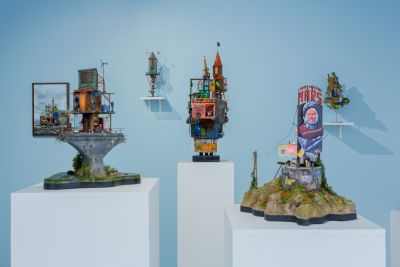When discovering the works of Simon Laveuve, one is tempted to think back to Dubuffet's quip that art “is always where you least expect it”. After decades of contemporary art displaying the ostentatious nature of its monumental creations in art venues built to the (dis)measure of their ever more imposing frames, we are witnessing the emergence of a new aesthetic trend that turns this quest for gigantism on its head, extolling the virtues of the miniature, a taste for the minuscule, attention to detail, and the reverie of intimate spaces. Simon Laveuve is certainly at the forefront of this desire to rediscover a more human scale of creation, even if it's 1/35, in a closeness that recaptures the wonder of childhood. In concrete terms, the artist born in 1988 in the Paris suburbs creates miniature sculptures of chimerical architectures. From old graffiti-strewn sheds and ramshackle huts to overgrown turrets, trash-colored lighthouses, improbably levitating ships, dilapidated platforms, buoys and Lilliputian rafts, Simon Laveuve's model sculptures present an almost surreal inventory of improbable habitats that have nothing to envy the architectural follies of Richard Greaves or the Palais du Facteur Cheval.
Belonging to a generation aware that we are living against a backdrop of widespread ecological crisis in a world on borrowed time, haunted by the spectre of a post-apocalyptic era, he explores the possibilities of surviving by living poetically in remote or inhospitable places. He thus imagines a world filled with “anachitectures” that defy the norms and principles of urban construction, like so many unusual shelters in the form of robinsonnades serving as refuges for the survivors of the future.
Like many artists born in the concrete of the great post-war urbanization projects embodying the brutalist architecture of the first half of the 20th century, Simon Laveuve questions the future of these urban spaces, often devastated by industrial desertization, and frequently appearing as non-places virtually devoid of humanity - future Territories of Waste, veritable “wastelands” punctuated by dilapidated shelters.
By offering a veritable manifesto of aesthetic savoir-vivre in the ruins of capitalism, the artist in no way subscribes to the collapsological nihilism of some. In fact, his visual universe has nothing to do with an anguished, gloomy dystopia, but rather bears witness to an act of resistance that appeals to the poetry of play and the virtues of the marvellous. From this point of view, the choice of miniature, far from signifying a kind of resigned closure, seems rather to be the royal road to the regeneration of our vanishing imaginations.
Whereas the gigantism of contemporary installations, whose deleterious impact on our potential for aesthetic reverie Annie Lebrun has never ceased to criticize, often plunges the viewer into a state of prostrate awe, miniaturized space turns its back on these canons by opposing them with other values: the humility of the artistic gesture rather than grandiloquence; a close-up view of the art object rather than a distant, hurried discovery; the patience of attention in preference to frantic zapping; the cult of secrecy, of hiding, rather than exhibitionist, expensive staging.
What's more, as Bachelard points out: “The minuscule, the narrow door if there ever was one, opens up a world. The detail of a thing can be the sign of a new world, a world which, like all worlds, contains the attributes of greatness. The miniature is one of the lodgings of greatness.
By incorporating tiny tire swings, rope ladders, furniture, works of art, wooden doors punctuated with scribbled messages and a variety of utilitarian objects into his unusual buildings, each object-miniature perfectly combines the hyperrealism of meticulously reproduced detail with the fantasy of a reality in a new, dreamlike dimension.
The abundantly colored, Lilliputian models can sometimes evoke the kitschy world of “chinoiseries” in Asian neighborhoods, the atmosphere of Caro & Jeunet's film sets, as well as that of SF or singular architectures, as the artist particularly appreciates the blending of genres and cultures.
Finally, Simon Laveuve's approach is a hymn to manual, self-taught creation; fully in keeping with a “modest art”, if not “poor”. Faced with excessive consumerist waste, the artist resorts to the systematic recovery of objects that he skilfully recycles in his constructions, following the example of the tin cans he makes abundant use of. By hijacking this emblematic object of consumerism, which Warhol elevated to the status of Pop Art icon, Simon Laveuve rediscovers the founding gesture of an aesthetic of play whose origin Walter Benjamin attributed to the genius of childhood.
Aren't children irresistibly drawn to the waste products of construction, gardening and domestic work? With these waste products, which they know how to divert wonderfully, don't they give shape to their own world of things, a little world within the big one, just by themselves?
Simon Laveuve draws on the childhood of art that Claude Lévi-Strauss observed survives into adulthood in the “wild thought” of the handyman, quick to use whatever he can get his hands on to realize his project. The famous anthropologist also saw in the scale model, “always and everywhere, the very type of work of art”.
- Philippe Godin, art critic












